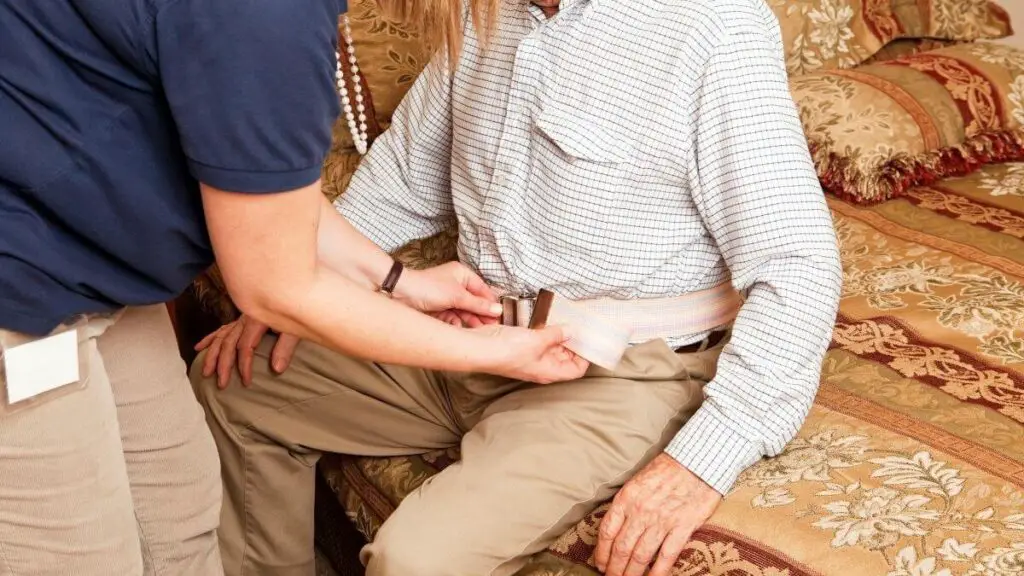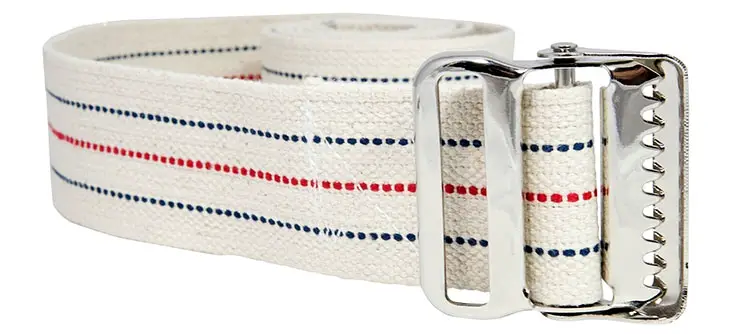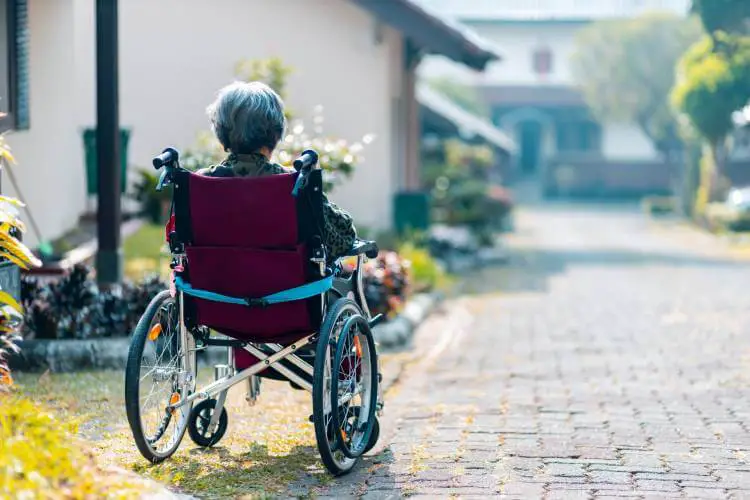Aging is often associated with a decline in muscle strength, balance, and flexibility. Orthopedic injuries can result in difficulties with walking around as well. For those with the greatest mobility challenges, this is where caregivers play a role and gait belts for seniors can come into play.
If you’re looking for the means to help a loved one move about their home without your injuring yourself, a lift belt is a fantastic tool to turn to. Here is everything you need to know about this great piece of gear.
What are Gait Belts?
A gait belt, sometimes called a gait belt, is a specialized belt that is strapped around an individual’s waist and is then used by their caregiver to help them ambulate.
The reasons that a lift belt is used are to:
- help somebody to walk,
- to help somebody get out of a chair, or
- to help somebody to retain their balance.
If somebody does not have the physical strength to get up out of a chair of their own accord, walk, or has terrible balance, a gait belt may be recommended. Without a gait belt, a care keeper may end up increasing their risk of injury as well as that of the individual they’re helping.
Let’s say that a loved one has suffered a stroke that has affected their left leg. They can still walk, but they have difficulty getting out of a chair, and their balance is off when they walk. Many people are given a gait belt during this time. A caregiver can then hang onto the gait belt to assist the loved one’s balance as they walk. Secondly, the caregiver can grab onto the gait belt to assist the stroke victim to get out of the chair.
Lift belts come in two main flavors, a heavy canvas-style belt and slicker, plastic designs.
In my experience working in a hospital setting to help improve people’s physical strength, canvas-style belts were widely used throughout healthcare settings until 2020, after which, a cleanable belt was preferred for use with multiple patients (particularly within physical therapy settings) and plastic belts began to grow in popularity.
While plastic belts are easier for cleaning in institutional settings, canvas-style belts are heavier-duty and stay “locked” better than do the plastic lift belts. Plastic style belts often loosen up the longer they are applied. Canvas-style belts are better suited for most at-home, personal use.
When Caregivers Need to Use Gait Belts
The physical demands of informal caregivers is significant. Caregivers should use a lift belt when a doctor prescribes them, or when it is otherwise unsafe to attempt an activity without one. In my experience, a few elderly women who are caring for their husbands after a surgery or stroke have greatly benefited by adding a gait belt to the equation.
Before these women were using a gait belt to help their husbands, falls were common, and the wives were hurting themselves trying to get their husbands up out of chairs, out of bed, etc. Proper lifting techniques should always be used no matter what is being picked up, but it is easier to do this with a gait belt than it is without it.
Without a gait belt to assist somebody, people often resort to trying to pick somebody up by the armpits. For whatever reason, older people tend to lift their arms when one tries to pick them up by the armpit. This makes it very difficult to keep a solid grip while assisting in a transfer. They’ll also hang onto somebody’s neck as somebody tries to pick them up – something which is incredibly dangerous.
An elderly lady’s neck is not going to be strong enough to lift a 250-pound man out of a chair. Nobody seems to realize this until it’s too late.
A gait belt helps in both circumstances. The armpits are taken out of the equation as the back of the waist is what’s being grabbed onto and because the caretaker is not directly in front of the stroke victim, the stroke victim doesn’t have a nearby neck they’re going to try to hang onto for everything they’re worth.
When Should You Not Use a Gait Belt?
There are certain medical conditions where gait belts are not recommended. According to Medline:
Some patients have contraindications that prevent them from utilize a gait belt, including: recent chest, abdominal or back surgery, abdominal aneurysm, G-tubes, hernias and severe cardiac or respiratory conditions.
https://www.medline.com/strategies/safe-mobility/elevating-patient-safety-gait-belts/
If the person that is being cared for does not have the physical capability to walk, using a gait belt to attempt to help them walk is not going to work. If somebody needs a wheelchair, they need a wheelchair. A gait belt is not a substitute for leg muscles.
While they can still be used to assist in transfers (e.g., from a wheelchair to a dining room chair), to try to use them to help somebody walk down a hallway who cannot physically walk at all is to set both of you up for failure and potential injury.
3 Great Gait Belts
Now that we’ve discussed what a gait belt is and how it can be useful, let’s look at what some of the best ones are out there on the market. We’ve examined what’s out there and narrowed it down to the following three choices. These are three great gait belts that you may want to consider…
Cow & Cow Transfer and Gait Belt
This is the style of gait belt that the author is most familiar with and has used extensively. These are very heavy-duty belts that will help you to do everything that a gait belt is designed for. For $10 these really can’t be beat.
Five different sizes are available to accommodate varying sized individuals – 40”, 54”, 60”, 72”, and 100”. The belt is made of 100% cotton, can be washed, and has a capacity of 350 pounds. Another nice feature of this belt is that it’s 2” wide as well. Attempting to help somebody with nothing other than a sliver of a ribbon around their waste isn’t practical.
You want a thick belt like this one if you’re going to use a gait belt. A one-year warranty comes with the purchase as well.
Vive Transfer Belt
This belt is fantastic for the price. It has six padded handles attached to it in a manner very similar to a Doty belt. These handles make hanging onto the patient much easier than what one experiences with a traditional gait belt.
- EASY MOVEMENT & TRANSFERS FROM A TRUSTED BRAND: Safely assist patients or loved ones with ease using our transfer belt. The 7 padded handles allow for support from any angle, reducing the risk of caregiver injury and preventing falls.
- COMFORT FIRST: Our transfer belt features 7 padded handles for a comfortable yet secure grip, making it easy for caregivers to assist their patients or loved ones.
In my experience, a traditional gait belt sometimes forces one’s wrist and fingers into an awkward position. Nobody has to worry about that here.
These belts can be washed if they get dirty as well and come with a 60-day guarantee. That’s not a great warranty here, but it’s better than nothing. Being only 55” in length, it needs to be understood that this belt is not for everybody. If working with somebody with a much larger waist, this belt may not be large enough.
That said, this is still a fantastic product.
Dr. Moe’s Solutions Gait Belt
Virtually identical to the Vive Transfer Belt is the Dr. Moe’s Solutions Gait Belt. It’s roughly the same price ($22), has a very similar handle structure, and is roughly the same length (50”) as well.
- ✅ REDESIGNED BY A PHYSICAL THERAPIST - Trust Your Healthcare Needs to a licenced Medical Professional. Gait belt was designed for the safety of both the patient and caregiver.
- ✅ SURE GRIP RUBBERIZED HANDLES - Handles are placed strategically to give the caregiver maximum leverage and control over the patient - others are not built that attention to detail. Handles are wipeable to ensure sanitary conditions making this product perfect for home, hospital or nursing home use..
The main difference here is that the handles are rubberized. There are pros and cons to rubberized handles (personally, I don’t think that they’re as comfortable), but if this is what’s being sought after, this is a good option.
A quick-release buckle is present here as well, making it so that the user can take the belt off with minimal fuss if they have Parkinson’s or some other tremor that keeps their fingers from being as dexterous as they used to be.
How to Safely Use a Gait Belt
To start, strap the belt around the individual’s waist as recommended in your belt’s user manual. You then will hang onto the back of the belt with a closed fist, walking close to the individual as they are walking. If you try to stand far away from the individual, you both are going to fall. You must be close to them.
If helping somebody to transfer from one chair to another, stand beside them, grab the belt at the small of the back, and ensure that you keep good lifting form as you assist the individual in transferring.
You are not picking up the individual and acting as their legs. You are there to assist. If the individual needs more than that, you need to seriously look at alternatives. A gait belt is not a movement panacea.
A picture is worth a thousand words, so a video should be worth even more. For more information on how to use a gait belt safely, check out this video below:
What is a Doty Belt?
If having to deal with picking a loved one up off the ground on a regular basis, one may want to consider investing in a Doty belt. A Doty belt us belt specifically designed to help lift an adult up off the floor.
Anybody who has ever tried to use a gait belt to assist an individual up off the ground understands just how difficult this is. The belt rubs against the fingers, and just having that one anchor point against the user’s stomach is uncomfortable. It also is difficult for multiple people to use a gait belt to pick somebody up off the ground as well – particularly if the person who has fallen is heavy and weak.
These are situations where a Doty belt excels. There are two versions of the belt available – a standard yellow version which would work for most individuals, and a bariatric red version which works better for heavier folks.
Lift Belts for Seniors Summary
A gait belt is a wonderful device that will help you to better care for your loved ones while also protecting yourself. If you are the primary caregiver to your loved one, you need to ensure that you are taking as much care of yourself as possible. Who will care for the loved one should you get injured? Can you afford to hire somebody? Can you afford a nursing home?
If the answers to these three questions are concerning, then you’ve just come to the final word as to why a lift belt is a very valuable tool. Further, if your loved requires a lift belt for mobility, you should consider additional safety features around the house including but not limited to:
What are your thoughts? Have you used any of the above gait belts? Let us know in the comments below.






